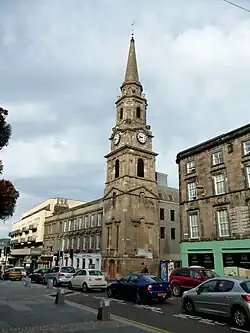Inverness Town Steeple
Town Steeple, Inverness is a Category A listed[1] building in Inverness, Scotland.
| Town Steeple, Inverness | |
|---|---|
 Town Steeple, Inverness | |
| Alternative names | Tolbooth Steeple |
| General information | |
| Town or city | Inverness |
| Country | Scotland |
| Coordinates | 56°42′5.5″N 3°43′11.6″W |
| Construction started | 1789 |
| Completed | 1791 |
| Height | 43 metres (141 ft) |
| Design and construction | |
| Architect(s) | Alexander Laing |
Listed Building – Category A | |
| Designated | 21 May 1971 |
| Reference no. | LB35153 |
History and architecture
The current structure replaced an ancient steeple which had existed since at least 1593. The building attached functioned as a tollbooth included a court and prison room. By 1692, the steeple also contained a clock which had been repaired by Thomas Kilgour.
The court and prison were rebuilt between 1789 and 1791; the old steeple was reported to be in a dangerous state and was rebuilt at the same time. The architect was Alexander Laing and the cost of construction was £1,598. A clock was provided for an additional £105 by Sir Hector Munro MP.
On 13 August 1816, the steeple was damaged by an earthquake.[2]
The attached court house and prison was demolished in 1853 and a row of shops replaced it, but the steeple was retained.
The steeple is built of ashlar and has seven stages. The current clock was built by James Bridges of Glasgow and the hour and quarters are struck on a set of three bells, with a ting-tang for the quarters. The mechanism of the clock was electrified in 1979 by James Ritchie and Sons of Edinburgh.[3]
References
- "2 Bridge Street and Church Street, Town Steeple". Historic Scotland. Retrieved 18 September 2023.
- "The Earthquake". Caledonian Mercury. England. 19 August 1816. Retrieved 18 September 2023 – via British Newspaper Archive.
- "Face to Face at Inverness". Aberdeen Press and Journal. England. 7 September 1979. Retrieved 18 September 2023 – via British Newspaper Archive.